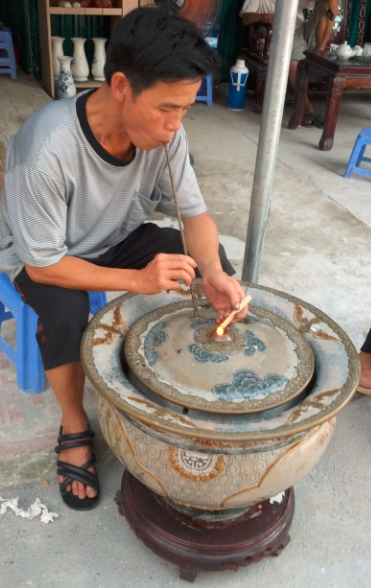Whenever I think of these brown malai laddus, I am reminded of my life in Jodhpur where I lived before I got married. Nothing to beat those melt in the mouth fresh laddus. The halwai (confectioner) would tell me to handle the cardboard box gently in which he would so lovingly line the laddus. But, by the time, I would reach home, some of them would have crumbled. But, the laddus would soon be devoured by the family. Who could resist the shine of the fresh laddus and the smell of desi ghee !
I wanted to make some sweets and savories for Diwali and they came out quite good.
Ingredients:
1cup besan / chick pea flour
Meanwhile, heat sugar and water. Let the syrup come to a boil. Turn off the heat.
As soon as you add the batter to ghee, it will start to cook with a hissing sound.

Add the boondis to syrup along with raisins and cashew nuts. Give it a good stir, cover and let the boondis soak the syrup for at least an hour.
Decorate with silver leaves, if desired.
I wanted to make some sweets and savories for Diwali and they came out quite good.
Ingredients:
1cup besan / chick pea flour
1/2 cup milk + a tbsp more, preferably whole milk
a pinch of turmeric powder
a pinch of baking soda
a pinch of baking soda
ghee for frying
for sugar syrup:
1 cup sugar
1/2 cup water
cooking camphor
seeds from 1 pod of black cardamom
seeds from 2 green cardamom
To be added to laddus while soaking in sugar syrup:
few rose petals
2 tbsp raisins
2 tbsp broken cashew nuts
8-10 almonds -slivered
8-10 almonds -slivered
Procedure:
Sieve besan in a bowl. This removes all the lumps in the besan and you get a smooth batter.
Add a pinch of turmeric powder. I do not like artificial colors so do not add them to my cooking. If, you want, you can add a little yellow color.
Now, gradually make batter with milk, adding it slowly and mixing it thoroughly.
Check the batter, it should be of dripping consistency.
Sieve besan in a bowl. This removes all the lumps in the besan and you get a smooth batter.
Add a pinch of turmeric powder. I do not like artificial colors so do not add them to my cooking. If, you want, you can add a little yellow color.
Now, gradually make batter with milk, adding it slowly and mixing it thoroughly.
Check the batter, it should be of dripping consistency.
Keep the batter aside for 5 to 10 minutes. Heat ghee in a wok on medium flame.
Meanwhile, heat sugar and water. Let the syrup come to a boil. Turn off the heat.
Dry roast slivered almonds and pieces of cashew nuts in microwave. You can roast them in a little ghee if you want. Crush black and green cardamom seeds.
Add, roasted nuts, black cardamom and green cardamom and a few rose petals to the syrup. Now, add a pinch of camphor but not too much. It should be enough to give you a pleasant smell because adding too much makes a person nauseous :(
Take the batter and pour a little of it on a slotted spoon. I unfortunately, have a very small spoon so had to struggle . This is not the correct equipment for making boondis since you need to have a larger slotted spoon
Remember the distance between the slotted spoon and wok should not be too much or else you will get tear shaped boondis.
It was a bit difficult to maneuver both the camera and spoon.
As soon as you add the batter to ghee, it will start to cook with a hissing sound.
The boondis will start getting a slightly brown color and the hissing will lessen.When the hissing lessens, this is a sign that the boondis are ready and need to be taken out.
Take them out on a plate. Cool them slightly.

Add the boondis to syrup along with raisins and cashew nuts. Give it a good stir, cover and let the boondis soak the syrup for at least an hour.
The boondis would have become soft by this time. Mash some of them so that they blend in with the syrup.
Take a little of the mixture while still warm, press with both hands to give a round shape.
Take a little of the mixture while still warm, press with both hands to give a round shape.
Decorate with silver leaves, if desired.
- In my experience, adding hot boondi to hot syrup makes the syrup crystallize quickly, so I prefer to add warm boondis to hot syrup. This way, I can do away with the hassle of ensuring proper sugar thread consistency.
- The consistency of the batter is important as a lot depends on the quality of the flour used. If needed, add just a spoonful of extra milk to the batter.
- Try not to compromise by frying boondis in oil. Lot of taste rests on the flavor of ghee.
- I deliberately use less sugar so I need to mash the boondis. You can increase the amount of sugar to 1 1/2 cup.
- If the boondis still do not form into laddus, heat the pan, the syrup will thicken a little bit and you will be able to make laddus easily.
- If, you feel that the boondis have not become soft, add a spoonful of hot water and mash them. They will become soft.

































